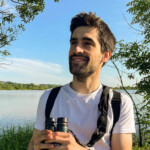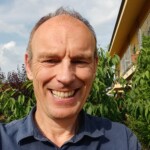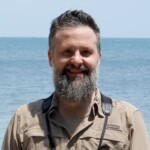#BOU2024 – Keynote abstracts
Urban birds
9 – 11 April 2024
Nottingham, UK & X(Twitter)
Alfred Newton Lecture
 A bird’s eye view of behavioral and demographic processes that shape avian communities in an urbanizing world
A bird’s eye view of behavioral and demographic processes that shape avian communities in an urbanizing world
Amanda D. Rodewald
Garvin Professor of Ornithology and Senior Director of the Center for Avian Population Studies, Cornell Lab of Ornithology and Department of Natural Resources and the Environment, Cornell University, Ithaca, NY
As the expanding footprint of cities envelops natural areas and brings humans in close contact with wildlife, there is growing urgency to understand the socioecological feedbacks that operate within urbanizing landscapes. A large body of literature shows that many of the defining characteristics of urban ecosystems, especially altered habitat structure, exotic plants, abundant mesopredators, anthropogenic food resources (e.g., birdfeeders), are associated with fairly predictable changes in avian community structure. Yet the behavioral and demographic mechanisms that underlie these community-level patterns remain poorly understood. From 2001-2014, my students and I studied birds within riparian forests distributed across a rural-to-urban landscape gradient in the U.S. Midwest. Consistent with previous work, we found that urbanization was negatively related to numbers of migratory birds but positively to residents and short-distance migrants. Behavioral mechanisms, such as settlement bias, territory selection, and resource-matching, explained many of the changes we detected better than demographic processes for our focal species. Despite mesopredator activity being much greater within urban than rural landscapes, we found no consistent signature on survival rates of adults, nests, or fledglings nor on annual reproduction. Instead, the manner in which predation affected bird populations was context dependent and strongly mediated by exotic plants and anthropogenic foods. In this lecture, I will share how human inputs fundamentally altered species interactions in ways that affected nest-site selection, the nature of predator-prey relationships, and the selective environment for breeding phenology and plumage coloration.
Amanda D. Rodewald is the Garvin Professor and Senior Director of the Center for Avian Population Studies at the Cornell Lab of Ornithology and the Department of Natural Resources and the Environment at Cornell University. Prior to joining Cornell in 2013, she spent 13 years as a professor at Ohio State University. She received a B.S. degree in Wildlife Biology from University of Montana, an M.Sc. in Zoology from University of Arkansas, and a Ph.D. in Ecology from Pennsylvania State University. Amanda leads an interdisciplinary research program that focuses on ecology, conservation biology, and socio-ecological dynamics in temperate and tropical ecosystems. Her recent research leverages participatory science / big data with field-based studies to address conservation challenges. She has published over 180 scientific papers, an Ornithology textbook, 10 book chapters, and over 70 popular articles and commentaries. Amanda is a fellow of the American Association for the Advancement of Science (AAAS) and the American Ornithological Society, from which she received the William Brewster Award in 2022. She also serves on the Science Advisory Board of the U.S. Environmental Protection Agency, has testified before Congress about conservation issues, and publishes regularly in The Hill about environmental policies. In addition to her research, Dr. Rodewald engages with a wide range of conservation practitioners, decision-makers, and leaders in government agencies, non-profit organizations, and the private sector to develop practical and innovative approaches to conservation that can accommodate social and ecological needs.
Keynotes
 Hormones in the city: do endocrine traits affect urban tolerance?
Hormones in the city: do endocrine traits affect urban tolerance?
Fran Bonier
Queen’s University, Canada
Species vary in their ability to cope with anthropogenic challenges, including urbanization. Many studies have characterized how hormone concentrations vary between urban and nonurban populations within species, likely reflecting plastic responses to urban challenges. However, these studies have failed to identify any patterns that can be generalized across cities or species. Other endocrine traits (e.g., endocrine plasticity, hormone receptors, negative feedback mechanisms) and other levels of variation (e.g., among-individual or among-species variation) might provide greater insight into links between endocrine traits and the urban ecology of birds. We investigated the potential for evolved variation in endocrine phenotypes to contribute to species-level differences in the ability to cope with urban challenges (hereafter, urban tolerance). We used quantitative estimates of urban tolerance for North American birds paired with decades of published data on hormone concentrations in the same species to investigate relationships between urban tolerance and endocrine phenotypes (specifically, baseline and stress-induced corticosterone and baseline testosterone). Our findings suggest that some endocrine phenotypes likely contribute to urban tolerance, but also indicate that other aspects of the endocrine phenotype, such as the ability to appropriately attenuate responses to urban challenges, might be important for success in cities.
Dr. Fran Bonier is an Associate Professor of Biology at Queen’s University in Kingston, Ontario, Canada. Her integrative research explores how organisms cope with diverse challenges like changing temperatures, disease, competition, and urbanization. She approaches this aim from several perspectives, often investigating plastic changes in behaviour, physiology, and life history to better understand adaptations to challenges. Although she has studied an array of organisms, from marine invertebrates to mountain lions, her current research focuses on birds (and burying beetles).
Causes and consequences of variation in the gut microbiome of urban and non-urban birds: insights from correlational and experimental data
Pablo Capilla-Lasheras
University of Glasgow, UK
Recent work highlights that the urban environment has a distinct microbiome, harbouring pathogenic species and antimicrobial resistance genes that could be transmitted to wildlife and humans. Interestingly, evidence suggests that urban birds have different gut microbiomes compared to their non-urban counterparts. However, the eco-evolutionary causes of this difference in gut microbiomes are not well understood. Amongst the novel stressors that birds face in cities, shifts in diet are prevalent, have negative survival consequences (particularly for growing nestlings) and can dramatically impact the composition of the gut microbiome. Here, combining correlational and experimental data on 16S amplicon sequencing and metagenomics, I show how the urban environment induces shifts in the gut microbiome of blue tits (Cyanistes caeruleus). These shifts are consistent and mediated by few bacterial taxa associated with urban environmental conditions. I then specifically explore the role of diet in driving gut microbiome changes in urban birds. Finally, I discuss the link between gut microbiome composition, growth, and survival in urban and non-urban birds.
Understanding how human-induced environmental change affects animals has become Pablo Capilla-Lasheras’ career purpose after a PhD in a pristine African landscape, studying the social lives of White-browed Sparrow Weavers. He takes an integrative approach and combines different disciplines. The goal of Pablo’s research is to understand the direct and indirect (e.g., via changes in animal behaviour) effects of human-induced environmental change on the dynamics of host-associated microbiomes, and their consequences for evolution, animal welfare and human health.

Linking bird communities and socio-economic status in urban areas
Dan Chamberlain
University of Turin, Italy
Urbanization has multiple impacts on the environment. However, though depauperate, the biodiversity that persists in urban areas may provide a range of ecosystem services. Such benefits are, however, often not shared equally across different levels of society, biodiversity typically being higher in wealthier areas of cities (the Luxury Effect) which creates environmental injustice. Given that the global urban human population continues to grow, there is a need to develop cities sustainably and equitably whilst minimising effects on the environment.
In this talk, I will use birds as an example group to consider two fundamental questions in urban ecology: How can we accommodate growing urban human populations whilst minimising impacts on biodiversity; and, how can we enhance urban biodiversity and ensure its benefits are accessible to all citizens? To formulate strategies for the sustainable development of cities, it is crucial to understand the relationship between biodiversity and its key drivers in urban areas, including habitat, disturbance, interactions with non-native species and socioeconomic context. I will present an integrated approach that involves understanding connections between natural value (i.e. features that maintain and enhance bird communities), societal value (i.e. how citizens value urban birds), and their interaction with socioeconomic aspects. The outputs can inform strategies for urban planning and management of green infrastructure (i.e. networks of healthy ecosystems) to enhance bird communities, and more generally biodiversity, for the benefit of urban residents across all levels of society, thus creating healthy, resilient cities for both people and birds.
Dan Chamberlain is Professor in Ecology at the University of Turin, Italy. In a career of nearly 30 years, he has produced a large body of work on the ecology of birds in a range of habitats. His current research has two main branches: assessing the impacts of environmental change on birds in alpine habitats; and, identifying drivers of urban animal communities, with a particular focus on the link between human socioeconomic status and biodiversity.
Urban bird disease dynamics: investigating the role of gardens and supplementary feeding
Hugh Hanmer
British Trust for Ornithology, UK
Urbanisation presents a major threat to avian diversity. Nevertheless, sizable bird populations persist in urban environments, with many species benefiting from the widespread provision of nesting sites and food in gardens. Supplementary feeding is carried out year-round by many millions of garden owners. Although this can benefit some wild bird populations, and provide vital human-wildlife engagement opportunities, there is growing evidence that supplementary feeding may also inadvertently alter pathogen transmission dynamics. Feeding stations create foraging hotspots, encouraging birds to congregate at unnaturally high densities for prolonged periods. When this is combined with poor hygiene levels, allowing the build-up of contaminated food waste and faeces, it is likely that supplementary feeding is placing birds at greater risk of disease transmission.
In this talk, I will explain how I have been using long term citizen science monitoring data, and other research techniques, to explore the spread of avian disease in and around urban areas. In particular, I will focus on recent and ongoing research by BTO and our Garden Wildlife Health partners into the severe decline of Greenfinch Chloris chloris and more recently Chaffinch Fringilla coelebs. These declines have been linked to finch trichomonosis, a strain of the protozoan parasite Trichomonas gallinae. Our research has identified gardens and, by implication, supplementary feeding as a potentially major factor in its transmission and spread. By considering the declines in these two common species alongside other research in this area we can better understand the impact of urban areas and gardens on our wild bird populations.
Hugh Hanmer is a Research Ecologist in the British Trust for Ornithology (BTO) Terrestrial Ecology team. His research primarily focuses on urban ecology and avian demography using long and short-term citizen science surveys alongside novel field surveys. He has a particular interest in the impacts of and human-wildlife interactions around garden bird supplementary feeding, first started during his PhD at the University of Reading and continued at BTO.
Flying colours over the city: the effect of urbanisation on the interspecific variation in plumage colour
Lucas M. Leveau
CONICET-University of Buenos Aires, Argentina
The urbanisation process is increasing around the world, especially in biodiverse regions where birds are colourful. However, little is known about the effects of urbanisation on bird colors at the community level. The objective of this talk is to synthesise results obtained at different spatial and temporal scales in the Argentine pampas, and through different ways of measuring plumage colour. Along urban-rural gradients, colour diversity was less than expected for a given number of species in the more urbanised areas. The seasonal variation in colours was also less than expected in the more urbanised areas. The gray color was the predominant one, indicating a role of camouflage in the community assembly. An analysis controlling for phylogenetic relationships between species and other life history traits showed that the more urban species had uniform plumage, in contrast to the non-urban species. Uniform plumage can also favor camouflage against possible predators. Finally, the use of colours that consider the ultraviolet spectrum showed that species that inhabit urban parks are more colourful than non-urban species. Because the parks are more wooded than the rural areas of the pampas, this result is consistent with global patterns of bird colour where more colourful species are in the evergreen forests. The results obtained suggest that plumage colour is an important trait determining the presence of birds in urban areas.
Lucas Leveau is an Independent Researcher at the National Council for Scientific and Technical Research of Argentina (CONICET). Dr Leveau obtained his PhD from the National University of Mar del Plata (Argentina) in 2014 and is currently a researcher and professor at the Institute of Ecology, Genetics and Evolution of Buenos Aires (UBA-CONICET). His main research topic focuses on the spatial and temporal patterns of bird communities in urban environments. During the last few years, Lucas has analyzed how urbanization homogenizes the composition of birds in cities from different regions, as well as the seasonal and interannual dynamics of bird composition. He is also interested in analyzing how urbanization acts as a filter for the bird species, considering traits such as diet, nesting, and plumage color. To date, Lucas has published 57 scientific articles and is a member of the editorial staff of ornithology and urban ecology journals.
Facing the urban tapestry: urbanization as a spatio-temporally filtering force for birds
Ian MacGregor-Fors
University of Helsinki, Finland
We know that urbanization represents a barrier for many wildlife species that dwell in the surroundings of cities, but why? To date, research has shown that the changes implied by urbanization and the functioning and development of cities represent a multi-dimensional ecological ‘filter’ for biodiversity. Among wildlife groups, birds have been extensively studied to understand this filtering process. Individuals colonizing an urban system or staying in a habitat that has been recently urbanized need to overcome both the extrinsic (e.g., urban infrastructure, food predictability, human activities, urban hazards, inter-specific interaction) and intrinsic filter variables, ranging from genetic to behavioral changes or adjustments. A robust body of knowledge has shown the importance of the behavioral component as part of this process, which may be a game changer for individuals facing the spatiotemporal dynamic urban filters, often after other traits and mechanisms have played their role. Studies have recurrently shown that the identification of cues by birds in novel systems—often determined by extrinsic factors—and learning processes, among other factors, have important impacts on decision-making and innovation (traits that have been linked with urban thriving). Thus, an integrative mechanistic framework was recently suggested based on the process experienced by birds that reach a city and manage to persist in the novel system (becoming urban ‘utilizers’) or those that dwell in an urbanized region and increase their fitness through behavioral responses and adaptations, leading to population persistence (becoming urban ‘dwellers’).
Ian MacGregor-Fors, Professor of Urban Biodiversity and Ecosystems at the University of Helsinki, is driven by a lifelong passion for birds. His research focuses on avian responses to human activities, particularly in cities and towns. He has published over 130 scientific papers, 27 book chapters, 4 books, and 25 popular science articles. Since 2012, he promotes the implementation of the UN’s Convention on Biological Diversity in cities as an Advisory Board Member of the International Network Urban Biodiversity & Design (URBIO).
Evolutionary ecology of biological clocks: insights from urban birds
Barbara Tomotani
Arctic University of Norway (UiT)
The process of urbanization causes dramatic changes in the environment and it is suggested to put organisms under contrasting selective pressures when compared to forests. Due to these strong and distinct pressures, and sometimes a restricted gene flow, organisms in cities are known to undergo rapid phenotypic and genetic changes. An obvious property of the urban environments is the amount of artificial light at night (ALAN) that could impact daily and seasonal rhythms. Circadian biological clocks allow organisms to anticipate daily events and are ubiquitous in nature. The light–dark cycle is the most important cue to synchronize (entrain) the circadian clock and the presence of ALAN in cities could dampen the light-dark cycle, making the cues in the urban environment noisier and potentially less predictable. Thus cities are suggested to select organisms with faster and weaker clocks and are interesting natural laboratories to investigate the evolution of biological clocks. In my talk I will discuss possible phenotypical differences in biological clock properties of city and forest birds that may lead to differences in their activity patterns. Then, I will show the results of our large common garden study with Great Tits (Parus major) from urban and forest origins in which we tested whether clock differences could be genetic. Finally, I will show the results of an experiment designed to test if the clocks of city birds are differently affected by light at night when compared to forest birds.
Barbara Tomotani is a researcher at the Arctic University of Norway (UiT) and a guest researcher at the Netherlands Institute of Ecology (NIOO-KNAW). Barbara is interested in the evolution of clocks and calendars of wild organisms and also studies how daily and seasonal timing is affected by anthropogenic changes in the environment.
Scientific Programme Committee
Christine Howard | Durham University, UK & BOU Meetings Committee (Chair)
Davide Dominoni | University of Glasgow, UK
Caroline Isaksson | Lund University, Sweden
Kate Plummer | British Trust for Ornithology, UK

